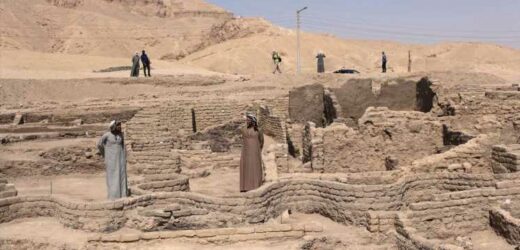CAIRO — Workers dig and ferry wheelbarrows laden with sand to open a new shaft at a bustling archaeological site outside of Cairo, while a handful of Egyptian archaeologists supervise from garden chairs. The dig is at the foot of the Step Pyramid of Djoser, arguably the world’s oldest pyramid, and is one of many recent excavations that are yielding troves of ancient artifacts from the country’s largest archaeological site.
As some European countries reopen to international tourists, Egypt has already been trying for months to attract them to its archaeological sites and museums. Officials are betting that the new ancient discoveries will set it apart on the mid- and post-pandemic tourism market. They need visitors to come back in force to inject cash into the tourism industry, a pillar of the economy.
►Unearthing history: Egyptian archeologists find 5,000-year-old tombs near the Nile River
►A mummy like no other: Researchers announce world’s first known case of pregnant mummy
But like countries elsewhere, Egypt continues to battle the coronavirus, and is struggling to get its people vaccinated. The country has, up until now, received only 5 million vaccines for its population of 100 million people, according to its Health Ministry. In early May, the government announced that 1 million people had been vaccinated, though that number is believed to be higher now.
In the meantime, authorities have kept the publicity machine running, focused on the new discoveries.
Wowing the world with new discoveries
In November, archaeologists announced the discovery of at least 100 ancient coffins dating back to the Pharaonic Late Period and Greco-Ptolemaic era, along with 40 gilded statues found 2,500 years after they were first buried. That came a month after the discovery of 57 other coffins at the same site, the necropolis of Saqqara that includes the step pyramid.
“Saqqara is a treasure,” said Tourism and Antiquities Minister Khaled el-Anany while announcing the November discovery, estimating that only 1% of what the site contains has been unearthed so far.
“Our problem now is that we don’t know how we can possibly wow the world after this,” he said.
If they don’t, it certainly won’t be for lack of trying.
In April, Zahi Hawass, Egypt’s best-known archaeologist, announced the discovery of a 3,000-year-old lost city in southern Luxor, complete with mud brick houses, artifacts and tools from pharaonic times. It dates back to Amenhotep III of the 18th dynasty, whose reign (1390–1353 B.C.) is considered a golden era for ancient Egypt.
Cairo gives 22 mummified remains of ancient leaders a "golden" parade on their way to the new National Museum of Egyptian Civilization.
Storyful
That discovery was followed by a made-for-TV parade celebrating the transport of 22 of the country’s prized royal mummies from central Cairo to their new resting place in a massive facility farther south in the capital, the National Museum of Egyptian Civilization.
The Red Sea resort of Sharm el-Sheikh is now home to an archaeological museum, as is Cairo’s International Airport, both opened in recent months. And officials have also said they still plan to open the massive new Grand Egyptian Museum next to the Giza Pyramids by January, after years of delays. Entrance fees for archeological sites have been lowered, as has the cost of tourist visas.
Bringing back Egypt’s battered tourism industry
The government has for years played up its ancient history as a selling point, as part of an effort to revive the country’s battered tourism industry. It was badly hit during and after the popular uprising that toppled longtime autocrat Hosni Mubarak and the ensuring unrest. The coronavirus dealt it a similar blow, just as it was getting back on its feet.
In 2019, foreign tourism’s revenue stood at $13 billion. Egypt received some 13.1 million foreign tourists — reaching pre-2011 levels for the first time. But in 2020, it greeted only 3.5 million foreign tourists, according to the minister el-Anany.
At the newly opened National Museum of Egyptian Civilization, Mahmoud el-Rays, a tour guide, was leading a small group of European tourists at the hall housing the royal mummies.
“2019 was a fantastic year,” he said. “But corona reversed everything. It is a massive blow.”
Tourism traffic strengthened in the first months of 2021, el-Anany, the minister, told The Associated Press in a recent interview, though he did not give specific figures. He was optimistic that more would continue to come year-round.
“Egypt is a perfect destination for post-COVID in that our tourism is really an open-air tourism,” he said.
Source: Read Full Article


